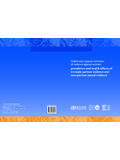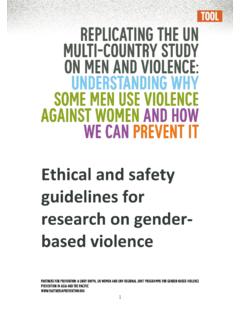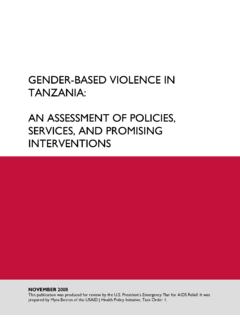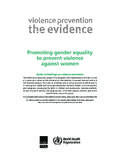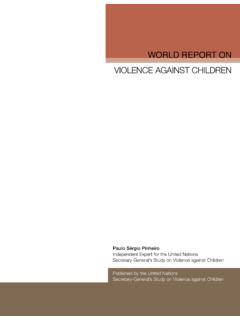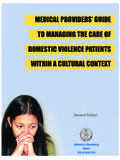Transcription of National Management Guidelines for Sexual Assault
1 National Management Guidelines for Sexual Assault October, 2003 1 National Management Guidelines for Sexual Assault October 2003 National Management Guidelines for Sexual Assault October, 2003 2 Contents Page i. FOREWORD 4 ii. ACKNOWLEDGEMENTS 4 iii. LIST OF ABBREVIATIONS 5 INTRODUCTION 6 RATIONALE 6 Magnitude 6 Factors influencing reporting cases 7 Medico-legal evidence 8 Health consequences of Sexual Assault 9 OBJECTIVES OF THE Guidelines 10 GUIDING PRINCIPLES 10 Principles guiding the Management of children under 14 years 11 INFORMATION TO THE PATIENT 12 CONSENT 12 Consent for the unconscious patient 13 Consent for children under 14 years of age 13 Consent for the patient with temporary mental incapacity 13 Consent for the mentally incompetent person 13 PATIENTS WHO DO NOT WANT TO REPORTING THE CASE 14 COUNSELLING AND PSYCHOLOGICAL SUPPORT 14 Counselling for HIV 14 Psychological support 16 EVALUATION OF A PATIENT OF Sexual Assault 18 History 18 Examination 20 INVESTIGATIONS 23 Sexual Assault Examination Kit 23 Oral swabs 24 Clothing 24 Evidence on patient s body 24 Pubic hair 25 Ano-rectal swabs 25 Genital specimens 25
2 Reference DNA specimens 25 Drugs and alcohol 25 HIV Test 25 Hepatitis screening 26 Investigations for children screening for STIs 26 National Management Guidelines for Sexual Assault October, 2003 3 Urine for pregnancy test 26 Urine for drugs screen 26 TREATMENT 26 Physical injuries 26 Tetanus prophylaxis 26 Pregnancy prophylaxis 26 STI treatment 28 Hepatitis B vaccine 29 Post exposure prophylaxis 29 Treatment of children 31 DOCUMENTATION 32 AFTER THE EXAMINATION 32 REFERRAL 33 FOLLOW-UP 33 MAINTAINING THE CHAIN OF EVIDENCE 34 GIVING EVIDENCE IN COURT 35 SPECIAL GROUPS 36 Older persons 36 People with disabilities 36 GLOSSARY OF TERMS 37 Patient/patient 37 Health care practitioner 37 Sexual Assault 37 Expert witness 38 Sexual Assault care Sexual Assault patient Medico-legal examination Mentally incompetent person Older person Temporary mental incapacity Unconscious patient Abrasion Bruise Laceration Incised wound Stab wound Gun shot wound ANNEXURES National Management Guidelines for Sexual Assault October.
3 2003 4 Foreword South Africa is said to have the highest incidence of Sexual Assault world -wide. The health sector response to this growing need has however not been optimal. In response to this growing concern, Cabinet announced on the 18th April 2002 that government would endeavour in provision of a comprehensive package of care for those who are survivors of Sexual Assault . The package would ensure that care for the survivors incorporates the best possible clinical, psychological and forensic care. These Guidelines are therefore particularly timely because of the growing concern of Sexual Assault in the country. The Management Guidelines have been produced to guide the provision of health care services as well as set the minimum acceptable standards for provision of quality care to the survivors of Sexual Assault . The development of the Guidelines involved consultation with experts in the field as well as extensive review of literature.
4 I wish to thank the task team for the excellent work they have done as well as the departments and organisations that provided their inputs and comments/participated in the development of the Guidelines . I would like to also thank all the health workers for their continued efforts to provide care to the survivors. Our responsibility as the guardians of women's health cannot be overestimated. Every effort has to be made to minimise inflicting further trauma to the victims of Sexual Assault , we owe it to the women of South Africa to make violence against them unacceptable not only because of the physical damage it does but also, and perhaps even more so, because of the psychological scars it leaves. I leave you with this thought in the words of one survivor of Sexual Assault : "The body mends soon enough. Only the scars but the wounds inflicted upon the soul take much longer to heal.
5 And each time I re-live these moments, they start bleeding all over again. The broken spirit has taken longest to mend; the damage to the personality may be the most difficult to overcome." DR MANTO TSHABALALA-MSIMANG MINISTER OF HEALTH National Management Guidelines for Sexual Assault October, 2003 5 ACKNOWLEDGEMENTS The National Maternal Child Women s Health and Nutrition Cluster would like to thank the technical group, which drafted the Management Guidelines and ensured that all relevant stakeholders were consulted and their views represented. The group drew on existing Guidelines from the following provinces: Western Cape, Kwa-Zulu Natal, and Gauteng provinces. The technical group comprised of: Dr Rachel Dewkes Ms Nicola Christofides Ms Lisa Vetten Dr Katrien Muller Ms Siyani Marima Ms Esther Maluleke Ms Sesupo Makakole-Nene Dr Pulane Tlebere Dr Loyiso Mpuntsha Dr Ameena Goga Ms Ray Mohlabi Mr Vusi Makgalemele Dr Busi Radebe The following persons are acknowledged for their contributions to the content of the Guidelines : Professor Lynette Denny and Dr Lorna J.
6 Martin (need to add affiliations of these two). Participants at the workshop, which was facilitated by the South African Gender Based Violence Initiative (SAGBVI) conference in (?month) 2003, are acknowledged for their inputs on some of the critical issues in the Guidelines . Many valuable comments were received from the National workshop participants from the following departments and organizations: Provincial departments of health SAGBVI CSVR WHP Rape Crisis Cape Town Trust Human Rights watch Phoenix Assessment and Therapy Center? Childline Section not complete - Check attendance list at workshop National Management Guidelines for Sexual Assault October, 2003 6 ACRONYMS AND ABBREVIATIONS 1. AIDS Acquired Immuno-Deficiency Syndrome 2. ARV Anti-Retroviral Therapy 3. AZT Zidovudine 4. CIAC Crime Information Analysis Centre 5. COC Combined Oral Contraceptive 6. CSDG Contraceptive Service Delivery Guidelines 7. CTOP Choice on Termination Of Pregnancy 8.
7 DNA Deoxy-Ribonucleic Acid 9. EC Emergency Contraception 10. ECP Emergency Contraceptive Pill 11. EDL Essential Drug List 12. EDTA Ethylene Diamine Tetra-acetic acid 13. HCF Health Care Facility 14. HIV Human immuno-deficiency Virus 15. IEC Information, Education and Communication 16. IUD Intrauterine Device 17. LNMP Last Normal Menstrual Period 18. MCS Microscopy, Culture and Sensitivity 19. OC Oral Contraception 20. PCR Polymerase Chain Reaction 21. PEP Post-Exposure Prophylaxis 22. POP Progesterone Only Pill 23. PTSD Post Traumatic Stress Disorder 24. 25. RTS Rape Trauma Syndrome 26. RPR Rapid Plasma Reagin 27. RTS Rape trauma syndrome 28. SAEK Sexual Assault Evidence Kit 29. SAECK Sexual Assault Evidence Collection Kit 30. SAPS South African Police Service 31. STI Sexually Transmitted Infection 32. 3TC Lamivudine 33. VCT Voluntary Counselling and Testing 34. VDRL Venereal Disease Research Laboratory National Management Guidelines for Sexual Assault October, 2003 7 National Management Guidelines FOR Sexual Assault INTRODUCTION Health care for Sexual Assault patients has to a large extent been a neglected area of service provision.
8 There are substantial gaps in services described in many parts of the country with repeated reports that the process of seeking health care and justice exposes patients to further trauma. Sexual Assault care in the health sector has to respond to the health needs of the patient. These include care for physical injuries; immediate and long- term psychological support; pregnancy prevention; STI prevention and treatment; HIV counselling and prevention; and social effects. They also include access to proficient medico-legal examination to gather evidence for the prosecution of cases. Sexual Assault care providers are therefore challenged to provide comprehensive Sexual Assault care by looking beyond the medico-legal needs of patients to their mental and physical health needs. These Management Guidelines aim to improve Sexual Assault care within the framework of a health service model, which puts the patient s health needs centrally.
9 These Guidelines form part of the National Sexual Assault Policy developed. They focus on the implementation of the policy framework wherever appropriate and will facilitate provision of high quality care for Sexual Assault patients. RATIONALE Health workers should be able to respond appropriately to the emotional status of the patient, recognise and treat life threatening injuries and offer adequate emergency prophylaxis against pregnancy, STIs and HIV. Health care practitioners should also be skilled and competent to document injuries and collect appropriate forensic evidence such that the courts are provided with high quality evidence to assist with the prosecution and conviction of perpetrators of Sexual Assault . The responsibilities of a health care worker looking after a patient of Sexual Assault are more complex than they are when looking after a routine patient.
10 They should ensure that the long term medical and social consequences of Sexual Assault are avoided or minimised by providing informed and competent services. The health care worker should also be able to interact and network with other professionals involved in the care and Management of the victim as well as know when and to whom to refer. Magnitude Sexual violence is a common event in South Africa. According to the Crime Information Analysis Centre, there were 52,550 cases of rape and attempted rape reported in 2000 of which 21,438 were of minors under the age of 18 years. There were also 2,934 cases of indecent Assault of men National Management Guidelines for Sexual Assault October, 2003 8 reported. This highlights the fact that both male and female are affected by Sexual Assault , but the highest risk group for Sexual Assault are children and young women and a large proportion of the patients seen will therefore in this age group.
